THE TRAGEDY OF THE HOLOCAUST
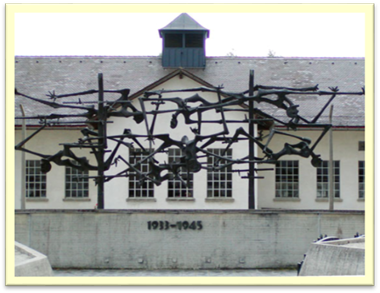
Entrance to the
Dachau Concentration Camp Memorial
Unit
Overview
As
the Allies raced toward Berlin in 1945, they encountered one of most horrific
aspects of the Nazi extremism. Adolf
Hitler had condemned all people that he believed to be inferior to
extermination in state-sponsored death camps.
Although some information surrounding their purpose had been leaked to
the outside world, no one was prepared for the cruelty and inhumanity of what
has become known as the Holocaust, a
Greek term meaning sacrificed by fire.
Let’s see how it all happened.
STOP: Answer Section A Questions
Hitler’s
Philosophy of Racism
As a
young man growing up in Austria, the
convictions of Adolf Hitler were molded by his exposure to extreme
Austro-German nationalists, who saw themselves as a superior people with
exceptional leadership skills. Along
with Vienna’s mayor Karl Lueger, he
favored a union between Germany and Austria based on the violent exclusion of
certain elements of society. These
included Jews, Slavs, Gypsies, Jehovah Witnesses, communists and homosexuals.
By the time he moved to Munich in
1913, Hitler was convinced that the Jews were the most serious threat to German
culture, unity and progress. The defeat
of Germany in World War I further solidified his position, and he blamed the
loss of the war solely on this group.
Hitler determined that to be Jewish was not a religious choice but a
scientific classification identified by certain physical characteristics. In Mein
Kampf (My Struggle), written in 1925, Hitler referred to northern
Europeans, including Germans, as the Aryans,
a master race destined to rule the world due to their intellectual and physical
superiority. He reasoned that this group
could only achieve greatness through ethnic
purity. Therefore, those people that
were considered inferior had to be destroyed.
Therefore, Hitler directed the Nazi Party to pursue a course of
political action that would accomplish this goal.

STOP: Answer Section B Questions
Anti-Semitism
and the Nazi Party
Anti-Semitism (prejudice
against or hatred of Jews) became a major part of the Nazi Party agenda. Four weeks after Adolf Hitler became
Chancellor of Germany, the Reichstag, a government building in Berlin which
housed the legislature, mysteriously burned.
The Nazis quickly blamed the Communists
for the fire, but some evidence suggested that the Nazis set the fire
themselves. Once state of emergency was
declared, Hitler manipulated the circumstances to suspend civil liberties, to
censor the press and to prohibit meetings of other political parties. Broad powers were granted to the Nazi-dominated
government. These actions set a
precedent for dealing with Germany’s Jewish population, which was publicly
branded as inferior and dangerous.
Hitler’s public speeches were filled with propaganda and logical
fallacies in an attempt to persuade German citizens to agree with his
views. Since their rights were no longer
protected, many Jewish lawyers, professors, doctors, musicians and government
workers lost their jobs in Germany by the end of 1934.
In
1935, Hitler announced the implementation of the Nuremberg Laws, a series of decrees which stripped German Jews of
their remaining civil rights. These
orders declared that Jews were no longer citizens and prohibited their marriage
with other Germans. Jews were excluded
from all artistic, literary and film enterprises; they were no longer permitted
to own or inherit farmland. The
government encouraged book burnings to destroy the work of Jewish scholars and
scientists. Anyone having one or more
Jewish grandparents was officially classified as a Jew. The laws succeeded in segregating the Jewish
population from the mainstream socially, economically and politically. Similar legislation concerning other
non-Aryans such as Gypsies and Slavs quickly followed. During the last half of the decade of the
1930s, over 120 additional ordinances dramatically changed the lives of those
who had previously thought of themselves as productive citizens.
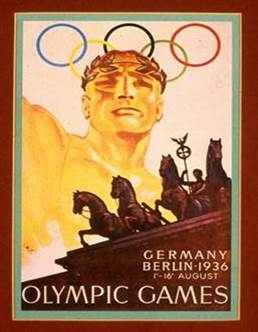
Official Poster of the Berlin Olympics:
1936
In
1931, the International Olympic
Committee (IOC) awarded the 1936 summer games to Berlin. The gesture
signified Germany’s return to the global community, but the IOC did not
anticipate Hitler’s rise to power. The
Nazis saw the event as a way to promote their ideology and the superiority of
the Aryan race. Propaganda Minister Joseph Goebbels hoped to use the event
as a showcase for the “new” Germany. The
nation built four huge athletic facilities, a polo field, an outdoor theater,
several swimming pools and an Olympic Village to house the competitors. Germany’s Olympic Committee quickly established
an Aryan-only policy for their team and deleted several world-class athletes
with Jewish and Gypsy backgrounds from the roster.
The
American contingent included Jesse Owens, a talented, African-American runner
and a non-Aryan. The United States
considered boycotting the games altogether.
Bowing to pressure from the IOC, Germany reluctantly agreed to allow
foreign Jews to participate and assured the United States that African
Americans would be treated well during their visit to Germany. As a result, the opening ceremony welcomed
5000 representatives from fifty-one nations.
Jesse Owens quickly became the super star of the XI Olympiad and earned
four gold medals. However, it was the
Nazis who benefitted the most from the Berlin Olympics. International journalists and tourists were
impressed by the lavish effort Germany had put into these games. Most visitors left with an image of a modern,
efficient German state rather than an oppressive, totalitarian government.

The Interior of a Jewish Synagogue
Trashed on Crystal Night
In
order to impress the foreign media, there was a brief respite in the violence
against Jews during the Berlin Olympics.
However, open anti-Semitism became increasingly accepted as a way of
life in the late 1930s. On November 7,
1938, a young Jewish man attempted to avenge the suffering of his family by
assassinating a member of the German embassy in Paris. The Nazis in Germany used this excuse to
unleash a wave of violence against the Jewish community, which became known as Kristallnacht (Crystal Night). In the course of this one evening, over 1000
synagogues were burned and 7000 homes as well as businesses were
destroyed. As an additional humiliation,
the Jews were forced to pay for the damages caused by this rampage. In the days that followed, the Nazis forced
German Jews to transfer the ownership of their businesses into Aryan hands, and
public schools were forced to expel all Jewish students.
STOP: Answer Section C Questions
The Ghettos
and the Camps
As
Hitler conquered Poland and moved into the Soviet Union, another eight million
Jews were threatened by Nazi anti-Semitic policies. Polish and Russian Jews were concentrated
into isolated areas of large cities called ghettos. These sections were sealed off with stone
walls and barbed wire. Curfews were
strictly enforced, and anyone caught outside the ghetto was usually killed
without explanation. Clothing, food and
fuel were difficult to acquire. Overcrowding
created serious health issues. For
example, the largest ghetto, located in the Polish city of Warsaw, held 400,000 people in a space that usually accommodated
10,000. Nonetheless, many Jews
struggled to keep their dignity and to maintain their traditions. When word of these appalling conditions
spread internationally, the Nazis quickly built a model ghetto called Theresienstadt near Terezin in Czechoslovakia to counter
these reports in 1941. The project
included manicured gardens, a well-stocked shopping district and new
schools. A Red Cross team of inspectors
was led to believe that this was a typical ghetto. German propaganda films pictured this as the
standard for resettlement. In reality,
Theresienstadt was simply a transit station as captives were moved to other ghettos
in Poland and the Soviet Union. The
ghettos, however, proved to be part of a greater long-range plan known as the Final Solution.

On
January 20, 1942, sixteen high-ranking Nazi officials met in the Berlin suburb
of Wannsee to discuss the Final
Solution. The Wannsee Conference established a concrete plan for the genocide, or total destruction of
Europe’s 11,000,000 Jews. Concentration camps were an essential
component of this strategy. The Nazis
had opened a camp near the German city of Dachau
in 1933 to house political prisoners.
Gradually, more facilities were constructed to confine Jews, Gypsies and
non-Aryans. Prisoners were frequently
shot and buried in mass graves. With a
more sinister purpose, six death camps were established in Poland in 1942. When the victims arrived, they were divided
into two groups. Those who were healthy
enough to perform heavy labor worked on government projects such as the
construction of roads and bridges.
Others were herded into gas chambers disguised as shower rooms and died
after being overcome with the effects of a prussic acid called Zyklon B. At Auschwitz,
the largest of these camps, up to 30,000 people were killed daily. With cruel efficiency, the Nazis then burned
the bodies in large ovens called crematoria. By the end of World War II, over 6,000,000
Jews had lost their lives as a result of this organized form of mass
murder.
STOP: Answer Section D Questions
Why
Didn’t They All Just Leave?
Why
didn’t those who were being persecuted by the Nazi regime simply leave? Many students have pondered this simple yet
complex question since the conclusion of World War II. The answer lies in the historical context of
the 1930s. Many European Jews had owned
homes, businesses and farms for several generations and saw themselves as true
patriotic citizens. The Jewish
population had served in the military during World War I and had been awarded a
large share of medals for valor and honor.
Therefore, it was inconceivable to many that the persecution would
continue. When Hitler came to power, the
laws targeting Jews in the Third Reich were passed and enforced gradually so
there was no opportunity to foresee the death camps and gas chambers. New arrivals in the concentration camps were
often forced to write postcards to their relatives describing pleasant,
positive surroundings and encouraging them to come willingly.
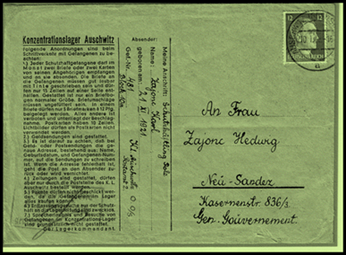
Postcard Sent from
Auschwitz: 1942
In
practical terms, the emigration procedures were complicated and expensive. Those wishing to depart had to prove that
they had valid travel arrangements and entrance visas for their new
destinations. Meanwhile, immigration
policies enacted by the United States and other nations restricted the number
of new arrivals. It was also necessary
to have a valid passport, a certificate from the local police and a document
stating that all tax accounts were current.
Germans were required to pay a twenty-five percent emigration tax on the
value of their assets before departing; German Jews paid an additional
twenty-five percent. A list of personal
and household property being removed from the country also had to be
submitted. Although 300,000 Jews left
Europe in the years preceding the war, many were not in a position to do so.
The
Resistance Movement
Although
the Holocaust claimed the lives of three out of every four European Jews, many
non-Aryans were saved through the efforts of various resistance groups. To combat
these movements, Germany passed the Nacht
und Nebel (Night and Fog) Order in
1941. It declared that anyone resisting
the implementation of Nazi policies would vanish into the night and fog. Nevertheless, attempts to thwart the Nazi
agenda continued. Benedictine nuns concealed Jews in their Polish convents while the Archbishop of Toulouse was an outspoken
opponent of violence against the Jewish population of France. Underground newspapers printed information
that went unreported by the Nazi-controlled press.
As
conditions for non-Aryans worsened throughout Europe, armed rebellions took
place in ghettos and camps. Although the
Warsaw Ghetto was destroyed and nearly all its 60,000 residents were killed,
the Jewish Fighter Organization
battled the Nazis for over a month with smuggled weapons. In 1944, there was also an attempt to
organize an uprising at Auschwitz. Four
women, including Rosa Robota and Ala Gertner, were able to obtain and to
hide small amounts of gunpowder.
Eventually, this was used to build a bomb and to blow up a
crematorium. Following an investigation,
the women were tortured and hanged within full view of their fellow
inmates. The Nazis hoped to deter other
acts of sabotage, but their harsh measures solidified and intensified the
resistance movement.
![[Warsaw Ghetto uprising]](SSWHU1719_Tragedy_Holocaust_image011.png)
The Warsaw Ghetto Uprising
STOP: Answer Section E Questions
Rescue
and Liberation
By
1944, the Allies were rapidly moving toward Germany and were encountering
thousands of concentration camp prisoners, who were suffering from starvation
and disease. The Soviets were first to
enter the major Nazi facilities in Poland.
The Nazis had forced the majority of the prisoners to march toward
Germany so the Soviets found very few prisoners alive. Before fleeing, the Germans attempted to
demolish the camps, but some gas chambers and crematoria were left standing as
a result of the quick evacuation. The
Soviets then moved on to liberate Auschwitz in January of 1945. Although only a few thousand struggling
captives were found, warehouses filled with clothing, including 800,000 men’s
suits, offered evidence that a mass murder had taken place at this site. As the Americans approached from the West,
they entered Buchenwald
concentration camp and released 20,000 emaciated inmates. The British forces advanced through northern
Germany and uncovered the same appalling conditions in the camp at Bergen-Belsen. Only after the liberation of these camps did
the world full realize the impact of Hitler’s racist policies.
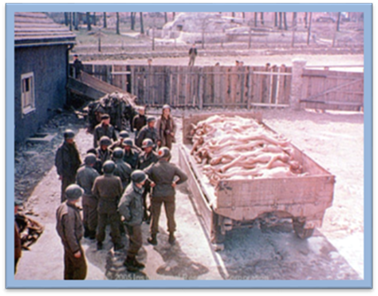
The United States Army at Buchenwald
Aftermath
When
the World War II ended, an international
military tribunal was formed to try high-ranking Nazi officials and certain
collaborating civilians for their participation in war crimes. Although there was no international precedent
regarding genocide as a crime, twenty-four defendants were named, and
twenty-two were prosecuted. The Allies
used confiscated Nazi documents and eyewitness testimonies to support their
case in a series of trials that took place in the German city of Nuremberg. Although the defense argued that only the
state and not individuals could be considered guilty, twelve men were sentenced
to execution while seven received lengthy prison terms. Three of the original defendants were
acquitted. The Nuremberg Trials established crimes against humanity as an
international offense.
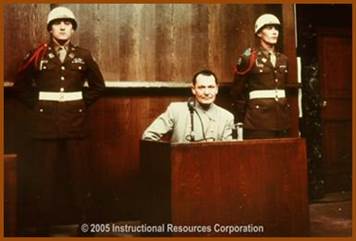
Hermann Goering on Trial at Nuremberg
The
survivors of the concentration camps discovered their torment did not end with
the defeat of Germany. Many had no homes
since their property had been confiscated; others were diseased and mentally
scarred. Anti-Semitism did not cease to
exist when the war was over due, in part, to a desire to retain the jobs and
property that the Jews had vacated. Some
officials insisted the atrocities had never occurred and refused to help what
remained of the Jewish population.
Holocaust survivors were housed in refugee centers administered by the United Nations Relief and Rehabilitation
Administration. A number of Jewish
agencies, such as the American Jewish
Joint Distribution Committee, worked to provide food, clothing and
vocational training. In 1945, U.S.
President Harry Truman relaxed the
quota restrictions on immigration for persons made homeless by the Nazi
regime. Over 400,000 immigrants made
their way to the United States with large numbers migrating to Canada,
Australia, New Zealand and Mexico as well.
Refugees also formed their own organizations and worked for the creation
of an independent Jewish state in Palestine.
With the establishment of Israel
in 1948, many displaced persons found a new home in the Middle East.
STOP: Answer Section F Questions
What
Does It All Mean?
The
Holocaust was not an accident or a fluke in history. It grew out of the social and political
climate of the interwar years as well as deeply rooted traditions of
intolerance and bigotry. Governments
enacted legislation that encouraged hatred, prejudice and, eventually, mass
murder. It serves as a reminder that
democratic values and human rights are lost if they are not appreciated,
protected and taught.
Additional Resources and Activities for this Unit

Unit 17 A History of
Anti-Semitism Article with Quiz